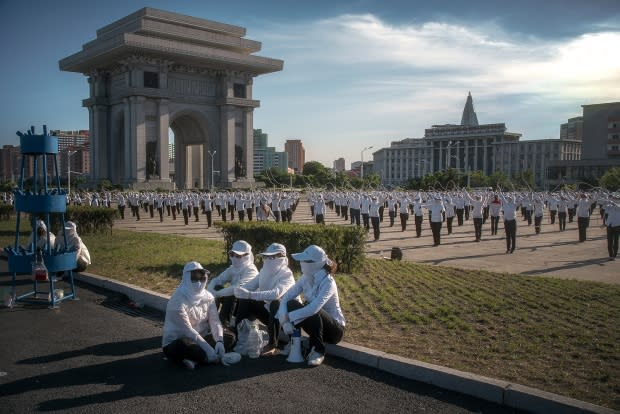Calgary-raised photojournalist leaves North Korea with trove of intimate images
A Calgary-born and raised photojournalist, now based in Vancouver, has published a book based on two trips to North Korea, normally considered inhospitable to foreigners.
Austin Andrews' Red Star Utopia: Inside North Korea is the product of a two visits to the country six months apart and a 36-hour train ride from one end of the country to the other.
He spoke with The Homestretch about what he learned and how it, at times, conflicted with his preconceived notions.
This interview has been edited and paraphrased for clarity and length. You can listen to the complete interview here.

Q: Why did you choose North Korea as a project?
A: It was a case of the right place at the right time. It's a country I have been fascinated with for some time.
A big part of my work as a photojournalist is to look at places that are underrepresented, underreported or misreported. There are few countries today, that that can be said about more than North Korea.
They were considering opening us this train route across the whole country to westerners for the first time.
It's a journey that goes through closed cities, these decaying centres of industry, mountain passes and parts of the country that hadn't really been seen previously.
I got in touch with the main company that facilitates travel into North Korea for westerners and made a pitch to take some photographs.
I had an opportunity to be the first tourist to take this local train without a guide and that formed the backbone of the project.

Q: Did the authorities know these photos would be published?
A: That's a hazard they are aware of with almost anyone entering the country.
It's almost a right of passage for westerners who visit to come back and post something.
My aim was to observe and to try to understand what it is to be a part of the rhythms and routines of this strange country that doesn't really exist anywhere else in the world.

Q: It's almost like being an explorer. Tell us about some of these photos you took and the stories behind them.
A: That was the real hope. To find images that represent the sum total of my experience in that country, to see some of those spots that reflect what life is like for the 25 million people who are going about their day-to-day lives.
While on the train it was the most incredible sensation. It was 36 hours from one side of the country to the other. The porter was keeping an eye on me, but otherwise I just had this compartment all to my own with this picture window, with a slow motion panorama of the countryside passing by.
There were, however, three points on the journey where soldiers had clearly been given a heads up that a foreigner was on the train.
They came into my compartment and were keen to seen what I was photographing and what my impressions were.
They went through my camera with great detail. Very few of those photos actually made it through, but my camera had a backup they didn't know about.

Q: How did some people react to you?
A: The train would go slow enough that people would watch it pass.
When they saw me, all kinds of hands would shoot up and point and gawk and laugh and smile and wave.
I felt like I had to break that ice and be a good ambassador for foreigners.
There are a couple different trips in the book, December last year and six months later, just before the U.S. president met with Kim Jong Un.
Seeing the shift in narrative in that six months was remarkable.
Last December there was propaganda everywhere and strongly anti-American images on the streets of Pyongyang. The American flag burning and variations of that.
All of that was gone six months later. The way people looked at me had changed.

Q: You captured some candid images, what kind of reaction did you get from subjects?
A: There wasn't the suspicion and wariness about me and my motives and intentions in North Korea that I had been accustomed to in certain countries in Africa or parts of the former U.S.S.R.
I was expecting more of that than I found.
Q: Which photos are the most representative of life in North Korea?
A: What drew my eye in are the images of people dwarfed by architecture and these massive civil engineering projects. They are everywhere and a sight to behold. I was very attracted to that.
It's also the images I was lucky enough to see out of car windows, train windows, in the margins, these fleeting glimpses. Kids playing on their way back from school. Droves of people from the countryside going into town for market day.
To see these strangely comforting and familiar routines that aren't that dissimilar from what we have here. The values and priorities for a lot of the people aren't that different from what they are here.
Everyone just wants to do the best they can and the best they know how.
With file from The Homestretch

